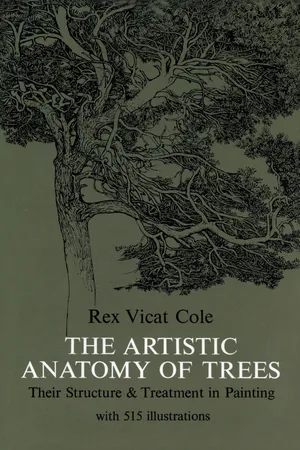
- 416 pages
- English
- ePUB (mobile friendly)
- Available on iOS & Android
eBook - ePub
The Artistic Anatomy of Trees
About this book
"Monumental book . . . Mr. Vicat Cole is a born teacher." — Contemporary Review
"Mr. Vicat Cole's ability as a landscape painter is well known, and he unites to his executive talents the qualifications of an accomplished teacher." — Connoisseur
"The name of the author is itself a guarantee that the subject is adequately treated. It is handled in a systematic and lucid way, which the novice . . . can follow with ease." — Studio
For years greatly admired and widely used, this excellent text by one of Britain's foremost art instructors has achieved the status of a classic in its field. The author, also a noted landscape painter, offers complete and accurate instruction in painting and drawing trees to all serious artists — beginner or advanced, amateur or professional. Its extremely comprehensive and detailed coverage has earned this volume a permanent place in the libraries of landscape painters, students, and teachers.
Every aspect of trees and how to depict them — in any style — is covered with unusual clarity and precision; problems of balancing tree groups, relations of light and shade, delicacy and weight, distance, sky apertures and their patterns, curves and straight lines in tree branches, tree color, the influence of special environmental factors (age, frost and snow, wind, moonlight), the effects of bud arrangements on the anatomy of trees, etc. Of special value is the very thorough and lucid analysis of tree anatomy: the proportion of boughs, branches, and twigs; the positioning of leaves on twigs; the form, texture, and color of leaves; leaf patterns; flower arrangement; stipules, bracts, buds, scales, spines, seedlings, the bark, and all the other essential details of structure. Specific information is given for each tree discussed: oaks, sycamores, willows, pines, maples, etc.; abstract and inaccurate generalizations are avoided. Nearly 500 illustrations by the author accompany the text, demonstrating all the anatomical features discussed. In addition, there are 48 full-page plates: magnificent landscape paintings and drawings by Giorgione, Rubens, Rembrandt, Van der Neer, Watteau, Hobbema, Turner, Gainsborough, Dupré, and many others, showing their compositional use of trees, their details in rendering, and similar material.
"Mr. Vicat Cole's ability as a landscape painter is well known, and he unites to his executive talents the qualifications of an accomplished teacher." — Connoisseur
"The name of the author is itself a guarantee that the subject is adequately treated. It is handled in a systematic and lucid way, which the novice . . . can follow with ease." — Studio
For years greatly admired and widely used, this excellent text by one of Britain's foremost art instructors has achieved the status of a classic in its field. The author, also a noted landscape painter, offers complete and accurate instruction in painting and drawing trees to all serious artists — beginner or advanced, amateur or professional. Its extremely comprehensive and detailed coverage has earned this volume a permanent place in the libraries of landscape painters, students, and teachers.
Every aspect of trees and how to depict them — in any style — is covered with unusual clarity and precision; problems of balancing tree groups, relations of light and shade, delicacy and weight, distance, sky apertures and their patterns, curves and straight lines in tree branches, tree color, the influence of special environmental factors (age, frost and snow, wind, moonlight), the effects of bud arrangements on the anatomy of trees, etc. Of special value is the very thorough and lucid analysis of tree anatomy: the proportion of boughs, branches, and twigs; the positioning of leaves on twigs; the form, texture, and color of leaves; leaf patterns; flower arrangement; stipules, bracts, buds, scales, spines, seedlings, the bark, and all the other essential details of structure. Specific information is given for each tree discussed: oaks, sycamores, willows, pines, maples, etc.; abstract and inaccurate generalizations are avoided. Nearly 500 illustrations by the author accompany the text, demonstrating all the anatomical features discussed. In addition, there are 48 full-page plates: magnificent landscape paintings and drawings by Giorgione, Rubens, Rembrandt, Van der Neer, Watteau, Hobbema, Turner, Gainsborough, Dupré, and many others, showing their compositional use of trees, their details in rendering, and similar material.
Frequently asked questions
Yes, you can cancel anytime from the Subscription tab in your account settings on the Perlego website. Your subscription will stay active until the end of your current billing period. Learn how to cancel your subscription.
No, books cannot be downloaded as external files, such as PDFs, for use outside of Perlego. However, you can download books within the Perlego app for offline reading on mobile or tablet. Learn more here.
Perlego offers two plans: Essential and Complete
- Essential is ideal for learners and professionals who enjoy exploring a wide range of subjects. Access the Essential Library with 800,000+ trusted titles and best-sellers across business, personal growth, and the humanities. Includes unlimited reading time and Standard Read Aloud voice.
- Complete: Perfect for advanced learners and researchers needing full, unrestricted access. Unlock 1.4M+ books across hundreds of subjects, including academic and specialized titles. The Complete Plan also includes advanced features like Premium Read Aloud and Research Assistant.
We are an online textbook subscription service, where you can get access to an entire online library for less than the price of a single book per month. With over 1 million books across 1000+ topics, we’ve got you covered! Learn more here.
Look out for the read-aloud symbol on your next book to see if you can listen to it. The read-aloud tool reads text aloud for you, highlighting the text as it is being read. You can pause it, speed it up and slow it down. Learn more here.
Yes! You can use the Perlego app on both iOS or Android devices to read anytime, anywhere — even offline. Perfect for commutes or when you’re on the go.
Please note we cannot support devices running on iOS 13 and Android 7 or earlier. Learn more about using the app.
Please note we cannot support devices running on iOS 13 and Android 7 or earlier. Learn more about using the app.
Yes, you can access The Artistic Anatomy of Trees by Rex V. Cole in PDF and/or ePUB format, as well as other popular books in Arte & Tecniche artistiche. We have over one million books available in our catalogue for you to explore.
Information
PART I
TREES CONSIDERED IN RELATION TO PAINTING

BLAIR ATHOL (LTBER STUDIORUM). J. M. W. TURNER, R.A.
CHAPTER I
THE PAINTING OF TREES ILLUSTRATED BY A CHRONOLOGICAL SERIES OF PICTURES, WITH SOME DESCRIPTIVE NOTES
THÉODORE ROUSSEAU was able, in the painting of a single tree, to impress us with the greatness of nature—with her very soul, if one may use the expression. In looking at his tree we are not disturbed by wondering whether it is an Oak or an Ash or botanically correct. We are content to look at it and come away, feeling that we have seen something grand and without a wish to analyse it. Sometimes out of doors we may see a tree which will excite the same feeling; but genius is given to few, and any attempt to depict on canvas the feeling we experience, unless it is backed up by a knowledge of construction, results in flabbiness—as is too often seen in the imitators of Corot. We cannot see with other men’s eyes, but we can study what they look for. By some our tree will be shown to us as a mere outline, but even that alone can express the severity or rhythm of its lines—lines that would give us pleasure in anything, but here give us the grace, dignity, or strength, as it may be, of the particular tree. Others will wish us to appreciate the tree as a bulk, and will accentuate its statuesque quality in which all details are submerged. Others, again, will find out wonderful shapes, and through them will appeal to our love of pattern, successfully as they extract its complete structure and intricacy of detail.
Constable painted his leaves with the real light of the sky upon them, and they had a rugged homeliness about them free from all convention.
Turner, with a larger view, and strengthened with his absolute knowledge of their construction, used trees at will, weaving magnificent compositions with them as in his “Cephalus and Procris” and “Near Blair Athol” of the Liber Studiorum (Plate II). He utilised them for every device at the command of art; in one place as bits of light or dark, in another as links between single forms; here as a piece of delicate leaf tracery like lace work seen against the sky, there as massed spaces of heavy foliage leading into the gloom. Sometimes his tree was a portrait, at others a specimen of the type—often a type evolved from many species—simply a tree—but nevertheless a possible tree. Whether it was the subtle undulations of the foliage or the severity of the lines of the trunks, he had a use for them. To him nothing came amiss; his sunlight shimmered on the leaves or poured through the in broad shafts of light; his branches stretched out from the trunk mixing in the blue of the sky: no detail was too trivial to make note of, not even the seams or the roughness of the bark or the single leaves and twigs that he drew so well.1
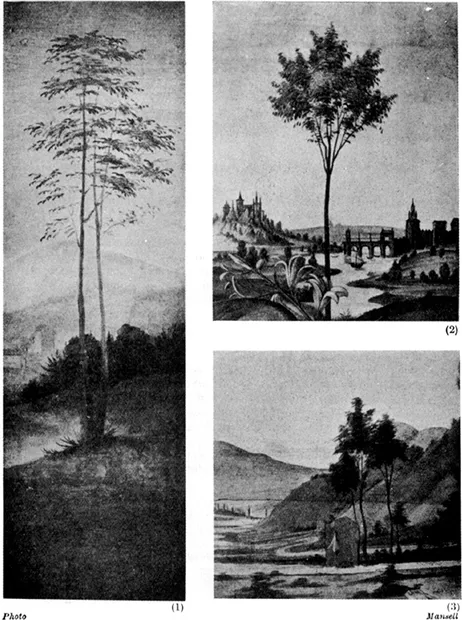
ILLUS. 1. PHOTOGRAPHS FROM PORTIONS OF THE PICTURES(1) VIRGIN AND CHILD AND THE INFANT ST. JOHN—Fra Bartolomeo(2) L’ANNUNZIAZIONE—Botticelli(3) VENUS AND CUPIDS—Sellaio
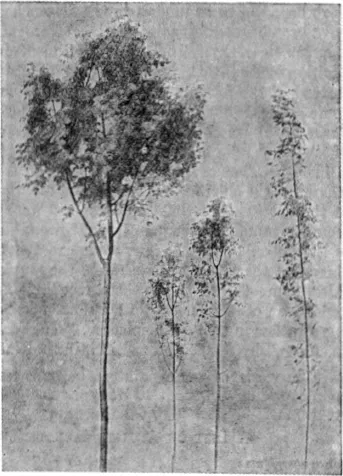
ILLUS. 2. A SKETCH OF SOME YOUNG TREES
Notice the likeness between the one on the left and Botticelli’s tree
From Titian and Patinier, the Fathers of landscape painting, to Cecil Lawson, we recall the names of those who have treated trees each in his own individual way. Titian, Giorgionc, Rubens, Claude, Rembrandt, Poussin, Salvator Rosa, Hobbema, Wilson, Gainsborough, Crome, Girtin, Turner, Constable, Cotman, Cox, Corot, Creswick, Diaz, Troyon, Müller, Rousseau, Daubigny, Monticelli, Cecil Lawson. To discuss adequately their points of view and their methods would require another book by another pen, but just to name them seems to brighten our minds and stir us to effort.
But our list should start with the Primitive Italians with their precise and delightful little trees painted in such an ingenuous way
with an infinite loving care. Their desire for an art, as something separate and different from ordinary life, seems to have guided them in the selection of just those trees that would satisfy it completely. Their trees were not, as some suppose, thought out formally, but were truthful copies of such as we find in our own copses to-day in the young trees that have been spared after the cropping of the underwood.
Here are three of them sketched the other day—just such as might have been taken as models in the fifteenth century, when they would have been beautifully painted; leaf after leaf standing out dark against a sweet clear sky. Their appreciation of delicacy, and the nice disposition of the little blocks of foliage up the stem might well be followed, instead of the formality in untruthful ugliness that is conjured up by some of our illustrators to-day. Another form is a compact and dense little tree covered with separate leaves as in the background of “The Virgin adoring the Infant Christ” by Lorenzo di Credi (Illus. 3). They are delightful, though in truth they resemble shrubs. These are the chief forms of trees that are associated with the paintings of that period, but that other aspects were also used then is evident from Giovanni Bellini’s painting of a wood in the picture, “The Death of St. Peter, Martyr.” The same exactness in copying the leaves is there, but the wood has depth, and the trunks give out branches on all sides, some towards us, others receding into the wood. The same veneration of nature even in her details is shown in the realistic painting of a lemon tree in the picture, “The Madonna, Infant Christ, and St. Anne,” by Girolamo dai Libri, in the National Gallery.
The work of some painters becomes more interesting if we remember when it was that they lived. Here is a list of those we mention:
A LIST OF ARTISTS MENTIONED IN THE TEXT

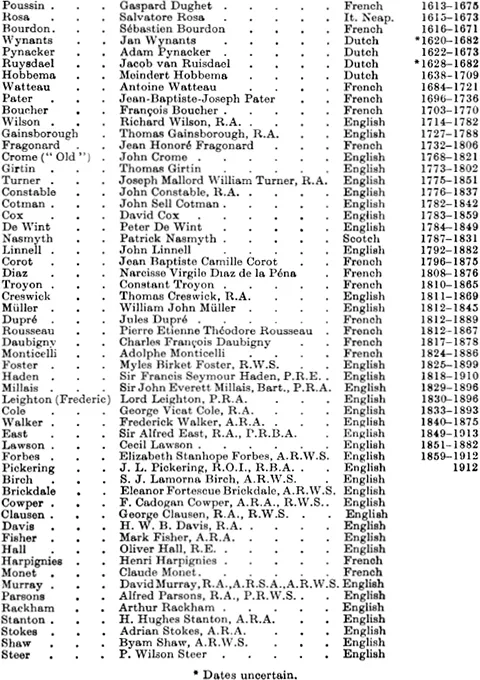

ILLUS. 3. TREES IN “THE VIRGIN ADORING THE INFANT CHRIST,” BY CREDI
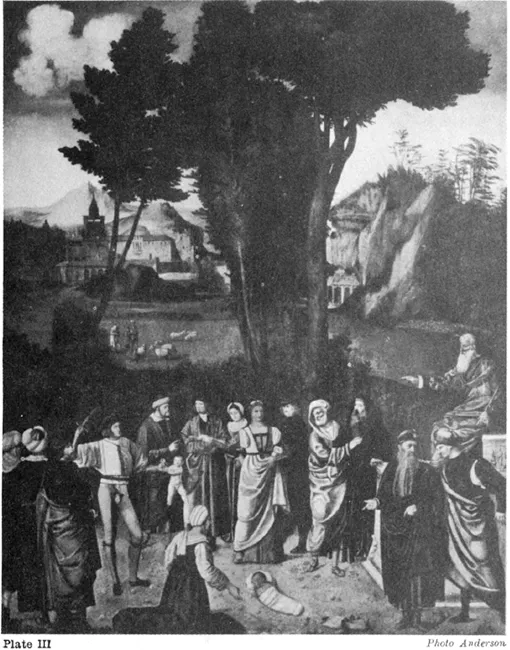
JUDGMENT OF SOLOMON. GIORGIONE (UFFIZI GALLERY)
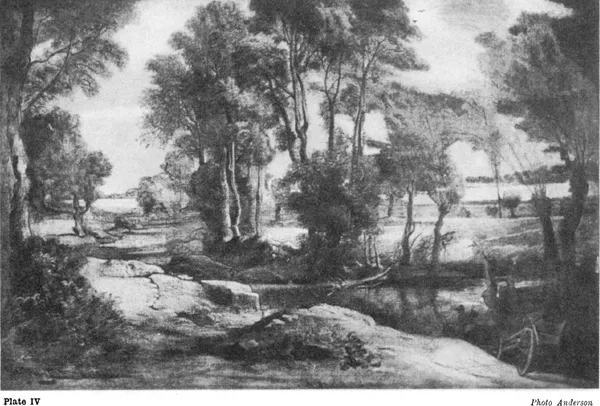
LANDSCAPE. RUBENS (NATIONAL GALLERY)
Notice how modern this beautiful landscape looks, and the shapes of the sky spaces.

A DRAWING IN THE BRITISH MUSEUM BY “GUERCINO” (BARBIERI)
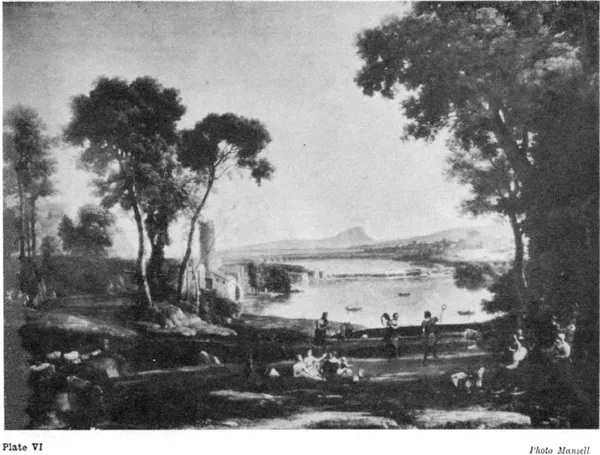
MARRIAGE O ISAAC AND REBECCA. CLAUDE LORRAINE (NATIONAL GALLERY)
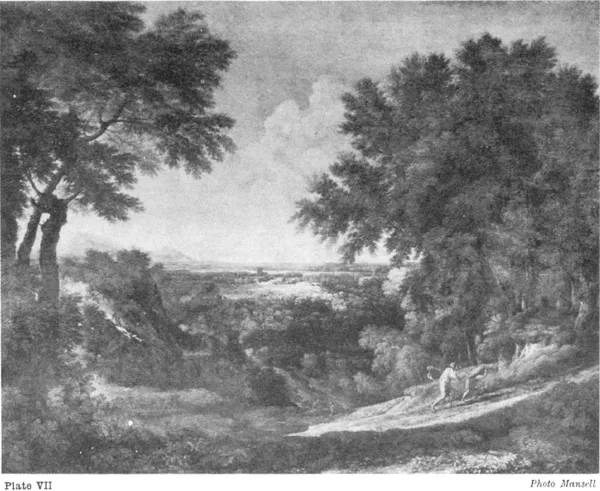
LANDSCAPE WITH FIGURES.GASPARD POUSSIN (NATIONAL GALLERY)
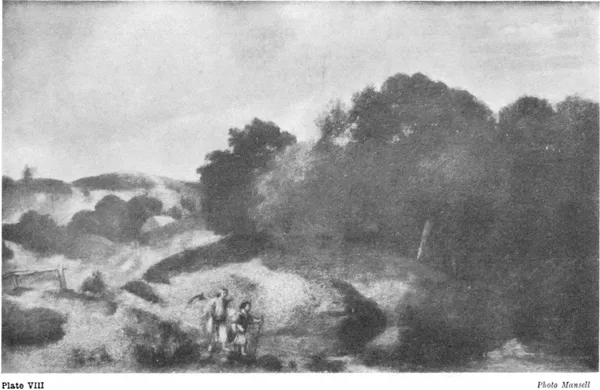
TOBIT AND THE ANGEL. REMBRANDT (OR SCHOOL OF) (NATIONAL GALLERY)
The treatment of this subject by Rembrandt and Salvatore should be compared as an extreme example of the predominating influence of temperament.
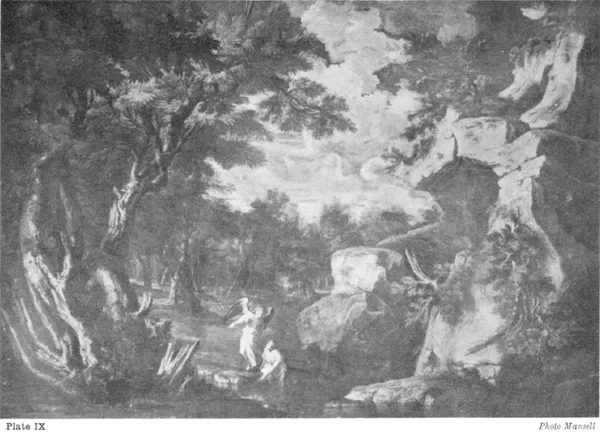
TOBIT AND THE ANGEL. SALVATORE ROSA (NATIONAL GALLERY)
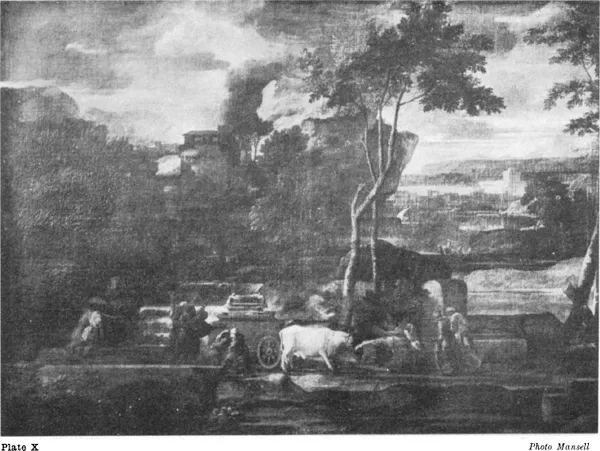
THE RETURN OF THE ARK FROM CAPTIVITY.SEBASTIEN BOURDON (...
Table of contents
- Cover
- Title Page
- Copyright Page
- Preface
- Note
- Acknowledgement
- Contents
- List of Plates
- General Introduction
- Part I: Trees Considered in Relation to Painting
- Part II The Anatomy of a Tree
- Part III: The Details of Trees
- Appendix—The Distribution of Trees in Europe
- Bibliography
- Index to Drawings by the Author
- Index to the Pictures reproduced in this Volume
- Index to Letterpress